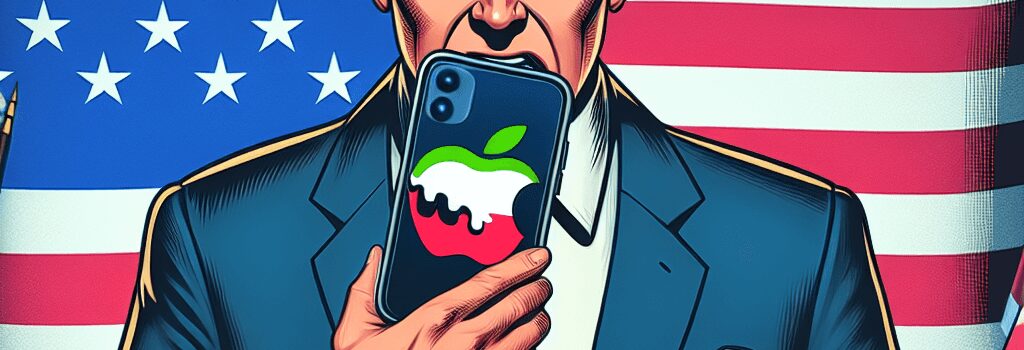Trump Threatens Apple with 25% Tariff on iPhones

Impossible Dream or Strategic Gambit?
On May 23, 2025, former President Donald Trump escalated his trade rhetoric by directly targeting Apple Inc., threatening a 25% tariff on all iPhones sold in the United States unless they are assembled on American soil. This unprecedented move—aimed at compelling Apple to relocate its flagship manufacturing operations from Asia to the U.S.—marks the first time the ex-president has singled out a domestic corporation for punitive duties.
“Only U.S.-made iPhones should be sold here. If that is not the case, a tariff of at least 25% must be paid by Apple to the U.S.” — Donald J. Trump, Truth Social, May 23, 2025
Key Points of the Tariff Threat
- Target: Apple’s iPhone assembly, currently centered in China, India, and Vietnam.
- Tariff Rate: 25% on U.S. sales of non–U.S.‐assembled iPhones.
- Legal Ambiguity: Tariffs are traditionally country‐level measures, not company‐specific.
- Timing: Coincides with stalling U.S.‐EU trade negotiations and fresh digital services tax threats.
Apple’s Manufacturing Footprint
Apple’s current global supply chain spans dozens of contract manufacturers, led by Foxconn and Pegatron. Their flagship iPhone 15 series uses chips from Taiwan Semiconductor Manufacturing Company (TSMC), camera modules from Sony, and memory from SK Hynix. Final assembly occurs primarily in Zhengzhou, China, but since late 2024, Apple has shifted up to 20% of U.S.-destined output to factories in Chennai, India, and is exploring lines in Hanoi, Vietnam.
Technical Specifications at Stake
- System-on-Chip: Apple A16 Bionic (5 nm node) – manufactured exclusively by TSMC in Taiwan.
- Display Panels: 6.1-inch LTPO OLED – supplied by Samsung Display, with backplane processing in South Korea.
- 5G Modems: Qualcomm X70 – fabricated on a 4 nm process.
- Battery Cells: Lithium-ion pouch packs – assembled in China by Desay Battery.
Economic and Consumer Impact
Wall Street analysts agree that relocating assembly to the U.S. would sharply increase costs. A Bernstein report estimates a 25%–35% production cost rise due to higher labor wages (average U.S. electronics assembler wages exceed $20/hour versus $3–$5/hour in China and India), stricter environmental compliance, and retooling expenses. Those costs could translate to a retail price hike from $999 to between $1,250 and $1,600 per unit.
Supply Chain Complexity and Cost Analysis
Building a “full-stack” U.S. facility faces technical hurdles:
- Chip Packaging: Advanced packaging lines (e.g., TSMC’s CoWoS and InFO) are only operational in Taiwan.
- Ceramic and RF Components: Modules for Wi-Fi 6E and mmWave 5G require precision wafer-level processes scarce in the U.S.
- Quality Control: Apple’s sub-ppm defect tolerance demands high-throughput optical inspection systems, currently concentrated in East Asia.
“Recreating the end-to-end iPhone manufacturing stack on American soil would take at least 5–7 years and over $50 billion in capital investment,” warns supply chain consultant Michael Chang of Gartner.
Alternative Manufacturing Hubs and Tariff Structures
In response to earlier tariff threats, Apple diversified its assembly to India and Vietnam, where effective tariff rates on smartphone imports remain below 10%. Both nations offer investment incentives under the Global Manufacturing Initiative, including land grants and tax holidays. Should the U.S. impose company-specific tariffs, Apple might pivot further, expanding capacity in Brazil under the Mercosur trade bloc or leveraging Indonesia’s FTAs.
Geopolitical Ramifications for Tech Supply Chains
Trump’s move comes amid stalled U.S.–EU trade talks and looming digital-services taxes in Europe. The European Commission has signaled potential counter‐tariffs, while China continues to levy duties on U.S. auto plastics and pressures to lift semiconductor export curbs. Such fragmented trade policies risk:
- Higher global smartphone prices.
- Supply chain bifurcation (U.S. vs. China/EU technology spheres).
- Reduced economies of scale for Next-Gen chips (e.g., 3 nm and sub–3 nm nodes).
Expert Opinions
Rebecca Liu, senior economist at the Peterson Institute:
“Selective tariffs on a single company set a dangerous precedent. They undermine WTO principles and could backfire by accelerating onshore R&D investments in rival nations.”
Dr. Alan Greene, professor of operations management, MIT:
“High‐precision electronics manufacturing has clustered in East Asia for decades. You can’t snap your fingers and replicate that ecosystem overnight.”
Looking Ahead
With Congress debating whether to reassert authority over presidential tariff powers, Apple remains in limbo. CEO Tim Cook has already earmarked $50 billion for U.S. investments (including a $1 billion campus in Arizona), but onshoring entire iPhone production would require a seismic overhaul of global supply chains. As Apple awaits clarification, the broader tech sector watches nervously—any escalation could redefine international manufacturing strategies for years to come.
Additional Analysis
1. Environmental and Sustainability Considerations
Relocating assembly domestically raises sustainability questions: U.S. manufacturing plants adhere to stricter EPA emissions standards, potentially increasing carbon costs unless matched by investment in renewable energy credits or on-site solar installations. Apple’s current supply chain has achieved 83% renewable energy usage in final assembly sites, a figure that could dip initially with U.S. expansion.
2. Impact on Component Suppliers
Component partners such as Broadcom, Cirrus Logic, and Texas Instruments would need to either open or expand U.S. fabs or risk supply chain fragmentation. The lead time to build a new analog IC fabrication line is typically 24–36 months, and could cost upwards of $3 billion.
3. Policy Precedents and International Law
Targeting a single company may conflict with WTO Most Favored Nation obligations and could invite challenges at the World Trade Organization. Previously, the U.S. only imposed broad category tariffs under Section 301 of the Trade Act, not company‐specific levies.